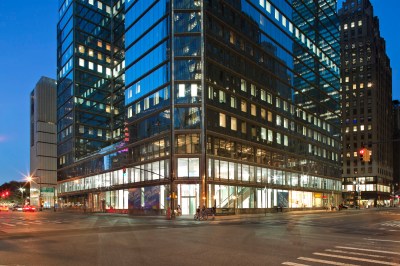All that Jazz: SL Green and CBRE Make Sweet Music at 3 Columbus Circle
By Daniel Geiger March 7, 2012 8:30 am
reprintsJazz, as many of its aficionados like to say, is all about collaboration.
So when the well-known performance venue Jazz at Lincoln Center recently turned an eye to its office lease, it didn’t forget that central tenet of the music it champions and hosts nightly in the large performance hall it developed in recent years on Columbus Circle.

The organization occupies about 30,000 square feet of office space at 33 West 60th Street, a building just a few doors down the street from its large performance hall in the Time Warner Center. The space is set to expire later this year, but though the not-for-profit didn’t need more space and loved both the landlord and location, its executives knew nonetheless that something just wasn’t right.
“We had grown to the point that we were spread out on four floors,” said Gordon Davis, a lawyer and longtime figure in the organization who is on its board and was charged with helping to oversee its real estate. “When you’re on multiple floors, it has a silo effect. Let’s just say it definitely doesn’t encourage the kind of collaboration you see between the musicians we have performing at the center.”
Because its performance venue at Time Warner Center is used primarily for events and shows, Jazz at Lincoln Center uses its office space to house almost all of its staff, which has grown considerably over the past decade as the organization has blossomed into a $40 million-a-year nonprofit. Mr. Davis said that the organization knew from the start of its search that it wanted to remain close to its landmark performance venue.
The space, which is in the northern annex of the Time Warner Center, was built as part of that twin-towered complex’s construction in the early 2000s. Jazz at Lincoln Center owns its portion of the space as a condo interest in the building and spent around $160 million to outfit it into a state-of-the-art performance hall. The venue is where it hosts its program of jazz performances and is also the centerpiece of its fund-raising efforts, both as a place to hold funding campaigns and through the revenue generated by ticket sales and by renting out its spaces for a slate of corporate events.
According to Mr. Davis, employees need to be able to shuttle back and forth from the office to the venue, sometimes multiple times a day. The Time Warner Center has office space as a component of the complex, of course, but Mr. Davis said that Jazz at Lincoln Center never really looked too hard at vacancies there because it is high-end, expensive space.
“The office rents here are a little bit above my pay grade,” he joked.
The requirement to preserve proximity created something of a challenge. Though Time Warner Center helped solidify the area as a commercial district, there are only a handful of office buildings in the neighborhood.
“It is kind of a niche market,” said Harly Stevens, an executive at CBRE (CBRE) who represents Jazz at Lincoln Center with colleague Jim Robbins. “There aren’t a lot of buildings and what properties there are are often full, like the Hearst Building and a number of buildings in the area that are leased by Fordham University. We knew from the beginning that we were really staring at a small selection.”
One property that had jumped out to everyone as a possible candidate, of course, was 3 Columbus Circle, an office that, though it’s not as close as 33 West 60th Street, is still only a few blocks away. That building seemed like a perfect fit save for the inconvenient fact that Joe Moinian, the property’s landlord, was nearing foreclosure to debt holders on the building, a group spearheaded perhaps ironically by the Time Warner Center’s developer Stephen Ross.
At the 11th hour, however, Mr. Moinian was able to recapitalize the project by bringing in SL Green (SLG), the city’s largest commercial landlord, as a partner.


